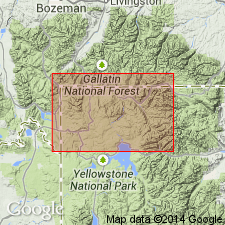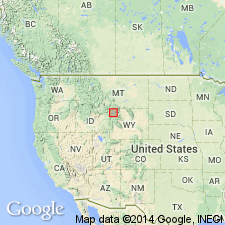
- Usage in publication:
-
- Osprey Formation*
- Modifications:
-
- Original reference
- Dominant lithology:
-
- Basalt
- Gravel
- AAPG geologic province:
-
- Yellowstone province
Summary:
Osprey Formation. Interlayered basalt flows and gravels. Subdivided into the informal basalt member and Tower Creek Gravel Member. Informal basalt member includes all basalt flows. Basalts are olivine tholeiites characterized by low content of alkali metals and sparse plagioclase phenocrysts; olivine present in groundmass. Are typically very fine-grained, dense, and nearly black. Columnar jointing is well developed. Tower Creek Gravel Member (previously called Tower Creek Conglomerate by Hague and others, 1896, USGS atlas accompanying Yellowstone National Park monograph, and Canyon Conglomerate by Weed, 1896, USGS Yellowstone National Park folio, no. 30) includes all gravel and other sediments associated with the Osprey Formation. [See also entry under Tower Creek.] At type section, the Osprey consists of six flows, several of which are separated by as much as 20 feet of gravel, particularly in lower part. Total thickness about 200 feet. Rests on an eroded Eocene intrusive body which forms Bunsen Peak. Elsewhere, fills or partly fills canyon paleotopography cut in upper part of Yellowstone Tuff (about 0.6 Ma) and in conformably overlying basalts. Overlain by tills of probable late Bull Lake age and younger deposits. Age is considered Pleistocene.
Type section:
Named for cliff exposures on west side of Sheepeater Canyon, 3,200 ft almost due north of Osprey Falls (the type section) and just east of closest approach in this vicinity of Bunsen Peak Road to rim of canyon, Yellowstone National Park, Yellowstone province, WY. Consists mainly of six black columnar-jointed basalt flows (basalt member), several of which are separated by as much as 20 ft of gravel (named Tower Creek Gravel Member). Occurs along Yellowstone and Lamar Rivers. Fills or partly fills canyon paleotopography out in Yellowstone Tuff and in Eocene volcanic rocks. Overlain by tills of Bull Lake and of Pinedale age. Assigned to the Pleistocene. Age assignment determined by position above Yellowstone Tuff, or Eocene volcanics, and below Pleistocene glacial deposits.
Source: GNU records (USGS DDS-6; Denver GNULEX).

- Usage in publication:
-
- Osprey Basalt*
- Modifications:
-
- Revised
- Redescribed
- Dominant lithology:
-
- Basalt
- AAPG geologic province:
-
- Yellowstone province
Summary:
Formerly called Osprey Formation and thought to include basalts and minor interlayered gravels in the northern Yellowstone Park area, WY, Yellowstone province younger than Swan Lake Flat Basalt (new). Sediments and basalts of The Narrows excluded from Osprey; name changed to Osprey Basalt. Partly fills deep canyons eroded into Lava Creek Tuff (new) and Swan Lake Flat Basalt. IS overlain by late Pleistocene glacial deposits. Belongs to the third volcanic cycle of the Yellowstone Plateau.
Source: GNU records (USGS DDS-6; Denver GNULEX).
For more information, please contact Nancy Stamm, Geologic Names Committee Secretary.
Asterisk (*) indicates published by U.S. Geological Survey authors.
"No current usage" (†) implies that a name has been abandoned or has fallen into disuse. Former usage and, if known, replacement name given in parentheses ( ).
Slash (/) indicates name conflicts with nomenclatural guidelines (CSN, 1933; ACSN, 1961, 1970; NACSN, 1983, 2005, 2021). May be explained within brackets ([ ]).

